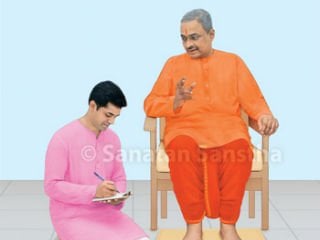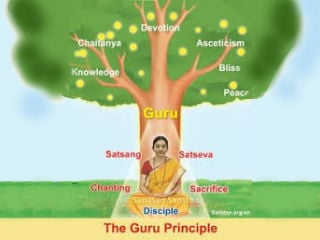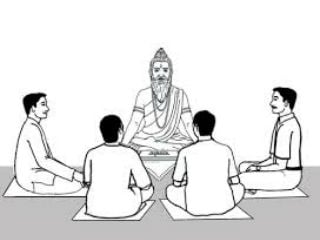The best Gurus are the ones who teach how to become active for the protection of the Nation and Dharma as a part of sadhana (Spiritual practice) when the Nation and Dharma are under threat, instead of getting engrossed in devotion to God. The best Guruseva (Service unto the Guru) in today’s adverse times is to direct our efforts for the protection of the Nation and Dharma.
Meaning of the word ‘Guru’
The Guru is one who eliminates the covering of Maya (The Great Illusion) in the form of ignorance enveloping the spiritually curious people, the seekers and the disciples, and makes them aware of their true self. The Guru is one who shows the way to realise God through His own behaviour and guidance, and in the end, actually makes them realise God.
So-called Saints today malign the word ‘Guru’
Today there are many so-called Saints who malign the very words ‘Saint’ or ‘Guru’. Here are a few examples.
1. ‘Some anti-Sanatan Dharma people put on the robes of a ‘Shankaracharya’ and loot Hindus in the name of Dharma.’ – Swami Avimukteshwaranand
2. In the Prayag Kumbha Mela of 2013, a so-called ‘Baba’ used to make Bharatiya devotees wait outside his tent and would be busy speaking to the foreigners the entire day. He also gave the status of ‘Mahamandaleshwar’ to some foreign disciples.
Due to such so-called Saints only, the status of the ‘Guru’ gets tainted and the faith of people in the Guru (and consequently in Dharma) gets shaken. Saint Tukaram Maharaj has suggested a way to handle such so-called Gurus. He says, “Those who exhibit false detachment but internally enjoy materialistic pleasures should be beaten with shoes.” We will have to ponder over whether or not we are carried away by such bogus and so-called Saints.
Who is a real Guru ?
1. H.H. Bhakataraj Maharaj (Baba), Sanatan Sanstha’s source of Inspiration would say, “There are many Gurus who impart God’s Name to disciples; but there are very few who perpetuate God’s Name in them, and these are the real Gurus. Many Gurus impart God’s Name and say, ‘Chant this Name daily for so-and-so number of malas’. However, when a real Guru gives the Name, due to His energy of resolve, the individual does not need to chant the Name with effort; because the chanting continues in his mind automatically”.
When such a Guru gives a Name to an individual and if he gives up sadhana, the Name does not leave him. Such is the great power that dwells in a real Guru. Many of H.H. Baba’s devotees have experienced this.
2. Saint Pujya Das (Raghuveer) Maharaj from Banda, Sindhudurg is a disciple of Shridharswami. When Pujya Das Maharaj came to Sanatan’s Ashram in Goa to meet Paratpar Guru (Dr.) Athavale (Founder of Sanatan Sanstha), He had the vision of His Guru in Paratpar Guru (Dr.) Athavale and went into a state of bhav (Spiritual emotion). Real Gurus have the power of bestowing the spiritual experience of such a superior quality in the first meeting itself. This has happened not only with Sanatan’s seekers, but others in the society too.
These examples are enough to realise the worth of a real Guru.
Types of Gurus in ascending order
In fact, all Gurus possess the Gurutattva (Guru Principle). The Gurus should never be compared. However, in today’s Raja-Tama-predominant times, if sadhana is performed under the guidance of an appropriate Guru, one can progress faster, realise God and get liberated from the cycles of birth and death. Hence, the types of Gurus are given ahead in ascending order.
1. Gurus who give the hope of
fulfilling desires and teach sadhana accordingly
A renowned Guru appeals to His devotees, “I will solve all your worldly problems; but you chant the Name I suggest”. Though the objective (that the devotees chant God’s Name) of the Saint is good, it is not appropriate; because such an appeal entraps the devotees in Maya in a way. Such a devotee cannot tread the path to God-realisation in the true sense.
2. Gurus who suggest only vyashti sadhana
Vyashti sadhana means making efforts for individual spiritual progress. Samashti sadhana means making efforts for the spiritual progress of the society. Some Gurus teach only vyashti sadhana. This means, the journey of the devotee takes place only from the subtle body to the universe; but they cannot complete the journey from the universe to the subtle body. Such devotees can only attain the state of Liberation; they do not realise God. After death, they have to perform samashti sadhana in the higher subtle-regions. Then only they realise God. Thus, many years are spent in reaching the state of God-realisation.
3. Gurus who tell devotees to spread
Spirituality while performing vyashti sadhana
As per the principle ‘Tell others whatever you know’, some Gurus teach their devotees how to spread Spirituality. Though appropriate, this teaching is not comprehensive. Here, the society is given due thought; but there is no concept of upliftment of the Nation and Dharma. Dharma is the lifeline of the Nation. If Dharma and the Nation are also facing constant onslaughts, how will the society survive ? If the society does not survive, how can a devotee perform sadhana and spread Dharma ? Similarly, due to constant onslaughts on the Nation and Dharma, not only does social life become unstable, the society is exploited and lives in a constant state of fear.
4. Gurus who also teach the spread of Spirituality and
protection of the Nation and Dharma along with vyashti sadhana
Every threat to the society, Nation and Dharma brings about bondage on our personal, social, national and religious life. Should not the real Guru, who leads a disciple on the path of Liberation, also lead him on the path to get liberated from this bondage ? In fact, such a noble act is the goal of a real Guru. Bhagawan Shrikrushna motivated His disciple Arjun, who was overwhelmed with emotion and had drifted away from duty, fight the Holy battle. and thus set an ideal of establishing the rule of Dharma. It is for this reason that we pay obeisance to Shrikrushna – ‘Krushnam vande Jagadgurum’ (I pay obeisance to the Jagadguru, Shrikrushna).
To sum up, it is important for the disciple to protect seekers (Virtuous people), annihilate the evil tendencies and reinstate Dharma as per the Guru’s guidance as part of his sadhana.

 The one and only Guru-disciple tradition of the Sanatan Sanstha which has proven special in...
The one and only Guru-disciple tradition of the Sanatan Sanstha which has proven special in... Who is proclaimed a Saint as per Science of Spirituality ?
Who is proclaimed a Saint as per Science of Spirituality ? Faith & Guru
Faith & Guru The Guru Principle
The Guru Principle Offering gratitude unto the Holy feet of the Guru is true Gurudakshina !
Offering gratitude unto the Holy feet of the Guru is true Gurudakshina ! Qualities of a disciple
Qualities of a disciple